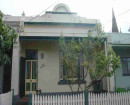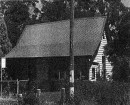GUNDOWRING HOMESTEAD
1350 GUNDOWRING ROAD GUNDOWRING, INDIGO SHIRE
-
Add to tour
You must log in to do that.
-
Share
-
Shortlist place
You must log in to do that.
- Download report







Statement of Significance
The exploration of Hamilton Hume and William Hilton Hovell into inland New South Wales and Victoria on route to the Port Phillip District in 1824-25 and the favourable reports of the land they had seen was a significant event in the colonization of Victoria. The exploration proved to be instrumental in drawing attention to the potential of the vast grazing lands sighted during their expedition. The explorations of the party were also undoubtedly of personal interest to the pastoralist Hume and no doubt influenced other members of the Hume family in taking up pastoral land in northern Victoria and southern New South Wales near to the Murray. Hume also had significant associations with the Port Philip district through his marriage to Elizabeth Dight, a sister of John and Charles Dight who built the water-powered flour mill on the Yarra River in the area which now bears the name of Dight’s Falls.
The Gundowring pastoral run is first recorded in the ownership of G Hume Barber in 1838. George Hume Barber had been a member of Hamilton Hume’s exploratory party which opened up the pastoral development of the Yass Plains, and was married to Hamilton Hume’s only sister Isabella. Barber lived at Glenrock Station near Marulan in New South Wales and the Gundowring run was from the outset actually run by his son, Charles Henry Barber [later Barbour] who first resided on the run as an eighteen year old in 1838. George Barber drowned in a flooded creek in 1844 and in 1845, Isabella Barber became the nominal proprietor of the run. In the same year, Charles Henry Barber married his first cousin, Mary Hume, a daughter of Elizabeth Hume who had acquired the nearby Yarroweya [later Yarrawonga] run on the Murray following the murder of her husband by bushrangers in 1840.
Charles Henry Barber initially lived in a bark hut at Gundowring. Barber planted willows on the property which had been grown from cuttings from the trees near to Napoleon’s grave on St Helena. The cuttings had been given to Barber’s father by Colonial Treasurer William Balcombe who had befriended the exiled Napoleon when Balcombe was an official of the East India Company at St Helena. After some years, Barber constructed the large brick homestead which still stands on the property. The date of construction of the house has not been established but the appearance of the house suggests a 1850s-1860s construction date. By 1857, Charles Barbour had assumed ownership of the property which he held until his death in 1882.
Barbour’s widow, Mary Hume Barbour sold Gundowring to John Macdonald in 1886. Macdonald became a Yackandandah Shire councillor, a Justice of the Peace, and was on the first Board of Directors of the Kiewa Butter Factory. After Macdonald’s death in 1923, Gundowring was sold to a Mr Elwood, and in 1944, Gundowring was bought by J Dale Crooke. The property remained in the Crooke family ownership for more than fifty years.
How is it significant?
Gundowring Homestead is of architectural and historical significance to the State of Victoria.
Why is it significant?
Gundowring Homestead is of architectural significance as a fine example of a large verandahed homestead in the Victorian Georgian style situated on one of the earliest pastoral runs taken up in Northern Victoria. The house is of interest for the unusual form of the ground floor windows where the upper sash slides into a wall cavity above.
Gundowring Homestead is of historical significance for its associations with pioneering pastoralist Charles Barbour, who occupied the pastoral run in 1838 as an eighteen year old and remained there until his death in 1882. The property is important for its association with Charles Barbour’s wife Isabella, the only sister of the celebrated explorer Hamilton Hume and a member of the pioneering Hume family which had an important role in the establishment of the pastoral industry of the Murray region of Victoria and New South Wales.
[Online data upgrade project 2005]
-
-
GUNDOWRING HOMESTEAD - History
The exploration of Hamilton Hume and William Hilton Hovell into inland New South Wales and Victoria on route to the Port Phillip District in 1824-25 and the favourable reports of the land they had seen was a significant event in the colonization of Victoria. The exploration proved to be instrumental in drawing attention to the potential of the vast grazing lands sighted during their expedition. The explorations of the party were also undoubtedly of personal interest to the pastoralist Hume and no doubt influenced other members of the Hume family in taking up pastoral land in northern Victoria and southern New South Wales near to the Murray. Hume also had significant associations with the Port Philip district through his marriage to Elizabeth Dight, a sister of John and Charles Dight who built the water-powered flour mill on the Yarra River in the area which now bears the name of Dight’s Falls.The Gundowring pastoral run is first recorded in the ownership of G Hume Barber in 1838. George Hume Barber had been a member of Hamilton Hume’s exploratory party which opened up the pastoral development of the Yass Plains, and was married to Hamilton Hume’s only sister Isabella. Barber lived at Glenrock Station near Marulan in New South Wales and the Gundowring run was from the outset actually run by his son, Charles Henry Barber [later Barbour] who first resided on the run as an eighteen year old in 1838. George Barber drowned in a flooded creek in 1844 and in 1845, Isabella Barber became the nominal proprietor of the run. In the same year, Charles Henry Barber married his first cousin, Mary Hume, a daughter of Elizabeth Hume who had acquired the nearby Yarroweya [later Yarrawonga] run on the Murray following the murder of her husband by bushrangers in 1840.
Charles Henry Barber initially lived in a bark hut at Gundowring. Barber planted willows on the property which had been grown from cuttings from the trees near to Napoleon’s grave on St Helena. The cuttings had been given to Barber’s father by Colonial Treasurer William Balcombe who had befriended the exiled Napoleon when Balcombe was an official of the East India Company at St Helena. After some years, Barber constructed the large brick homestead which still stands on the property. The date of construction of the house has not been established but the appearance of the house suggests a 1850s-1860s construction date. By 1857, Charles Barbour had assumed ownership of the property which he held until his death in 1882.
Barbour’s widow, Mary Hume Barbour sold Gundowring to John Macdonald in 1886. Macdonald became a Yackandandah Shire councillor, a Justice of the Peace, and was on the first Board of Directors of the Kiewa Butter Factory. After Macdonald’s death in 1923, Gundowring was sold to a Mr Elwood, and in 1944, Gundowring was bought by J Dale Crooke. The property remained in the Crooke family ownership for more than fifty years.
Sources:
Heritage Victoria File 602901
R V Billis & A Kenyon. Pastoral Pioneers of Port Phillip. 1972
R Spreadborough & H Anderson. Victorian Squatters. 1983
E Temple & D Lloyd. A History of the Kiewa Valley. 1989
Peter Freeman. Indigo Shire Heritage Study Sheet 2000. Data sheet for Gundowring Homestead.
G Serle [ed]. Australian Dictionary of Biography.
Australian Heritage Database. Data sheet for Glenrock Homestead, Marulan, NSW.
http://gundaroo.alphalink.com.au/genealogy/cemeteries/gun_gen/gun_gen.txt
members.iinet.net.au/~sgrieves/deaths_yass_courier.htm
GUNDOWRING HOMESTEAD - Permit Exemptions
General Exemptions:General exemptions apply to all places and objects included in the Victorian Heritage Register (VHR). General exemptions have been designed to allow everyday activities, maintenance and changes to your property, which don’t harm its cultural heritage significance, to proceed without the need to obtain approvals under the Heritage Act 2017.Places of worship: In some circumstances, you can alter a place of worship to accommodate religious practices without a permit, but you must notify the Executive Director of Heritage Victoria before you start the works or activities at least 20 business days before the works or activities are to commence.Subdivision/consolidation: Permit exemptions exist for some subdivisions and consolidations. If the subdivision or consolidation is in accordance with a planning permit granted under Part 4 of the Planning and Environment Act 1987 and the application for the planning permit was referred to the Executive Director of Heritage Victoria as a determining referral authority, a permit is not required.Specific exemptions may also apply to your registered place or object. If applicable, these are listed below. Specific exemptions are tailored to the conservation and management needs of an individual registered place or object and set out works and activities that are exempt from the requirements of a permit. Specific exemptions prevail if they conflict with general exemptions. Find out more about heritage permit exemptions here.Specific Exemptions:General Conditions: 1. All exempted alterations are to be planned and carried out in a manner which prevents damage to the fabric of the registered place or object. General Conditions: 2. Should it become apparent during further inspection or the carrying out of works that original or previously hidden or inaccessible details of the place or object are revealed which relate to the significance of the place or object, then the exemption covering such works shall cease and Heritage Victoria shall be notified as soon as possible. Note: All archaeological places have the potential to contain significant sub-surface artefacts and other remains. In most cases it will be necessary to obtain approval from the Executive Director, Heritage Victoria before the undertaking any works that have a significant sub-surface component.General Conditions: 3. If there is a conservation policy and planall works shall be in accordance with it. Note:A Conservation Management Plan or a Heritage Action Plan provides guidance for the management of the heritage values associated with the site. It may not be necessary to obtain a heritage permit for certain works specified in the management plan.
General Conditions: 4. Nothing in this determination prevents the Executive Director from amending or rescinding all or any of the permit exemptions. General Conditions: 5. Nothing in this determination exempts owners or their agents from the responsibility to seek relevant planning or building permits from the responsible authorities where applicable. Minor Works : Note: Any Minor Works that in the opinion of the Executive Director will not adversely affect the heritage significance of the place may be exempt from the permit requirements of the Heritage Act. A person proposing to undertake minor works must submit a proposal to the Executive Director. If the Executive Director is satisfied that the proposed works will not adversely affect the heritage values of the site, the applicant may be exempted from the requirement to obtain a heritage permit. If an applicant is uncertain whether a heritage permit is required, it is recommended that the permits co-ordinator be contacted.
-
-
-
-
-
GUNDOWRING HOMESTEAD
 Victorian Heritage Register H0367
Victorian Heritage Register H0367
-
'CARINYA' LADSONS STORE
 Victorian Heritage Register H0568
Victorian Heritage Register H0568 -
1 Alexander Street
 Yarra City
Yarra City -
1 Botherambo Street
 Yarra City
Yarra City
-
-










